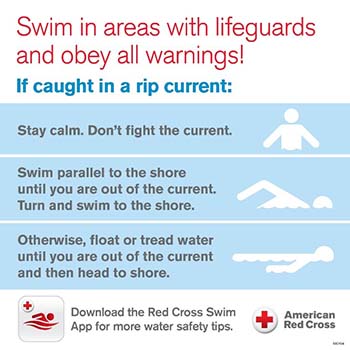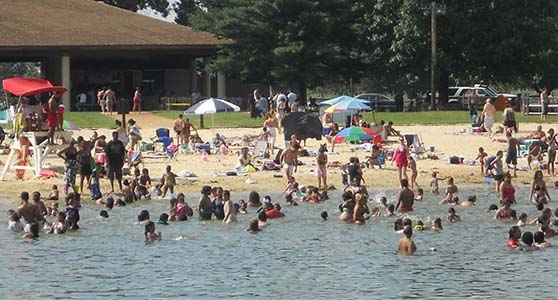|
FOR IMMEDIATE RELEASE |
Contact: Caryn Shinske (609) 292-2994 |
|
DEP URGES PUBLIC TO SWIM ONLY AT LIFEGUARDED AREAS AND PRACTICE (18/P060) TRENTON – – In the interest of public safety, the New Jersey Department of Environmental Protection reminds visitors to swim only at beaches where lifeguards are on duty, Commissioner Catherine R. McCabe announced today. At least five people have drowned this month in New Jersey waterways due to issues such as exhaustion, riptides and swimming at areas where there were no lifeguards present.
“New Jersey is fortunate to offer a wide variety of opportunities for water-related recreational activities – swimming in the ocean or at a lake, boating, kayaking and fishing, to name some,” Commissioner McCabe said. “We urge everyone to learn how to be safe in the water.” “The State Park Service operates designated lifeguarded swimming areas for our visitors’ safe enjoyment,” Assistant Commissioner for Natural and Historic Resources Ray Bukowski said. “It is dangerous and unlawful to swim in unguarded areas of state parks and wildlife management areas. If you get into trouble swimming in an unguarded area, not only are you putting your life at risk but also the safety and lives of emergency personnel and Good Samaritans. Visitors must follow the rules and swim only where there are lifeguards.” Before heading to the shore, the DEP and the American Red Cross remind visitors to understand the waterway they will be visiting, pack appropriate safety gear and remember these safety tips:
“Drowning can occur quickly and silently, wherever there is water,” American Red Cross New Jersey Region CEO Rosie Taravella said. “The American Red Cross encourages everyone to make water safety a priority as they enjoy backyard swimming pools or any of our state’s beaches, lakes and rivers this summer.” Rip currents can form in any large open water area and tend to form at low spots and breaks in sandbars, or near structures such as jetties and piers. They are often visible as ribbons of choppy water that flow perpendicular to the beach. Rip currents pull people away from shore; they do not pull people under the water. Drowning occurs when people pulled offshore are unable to stay afloat and swim to shore due to any combination of fear, panic, exhaustion, or lack of swimming skills. Swimmers caught in a rip current should do the following:
For more water safety information from the American Red Cross, visit www.redcross.org/watersafety For more information on New Jersey’s parks, swimming schedules and the Pocket Ranger mobile phone app, visit www.nj.gov/dep/parksandforests/ Like the New Jersey State Parks, Forests & Historic Sites Facebook page at www.facebook.com/NewJerseyStateParks/ Follow the New Jersey State Park Service on Instagram @newjerseystateparks Follow the DEP on Twitter @NewJerseyDEP
|
|
 With risks at waterways ranging from ponds to the ocean, the public must be extra cautious around all bodies of water, no matter how inviting and refreshing they may appear. There may be unseen hazards such as rip currents in the ocean, a deceptively swift current in a river, or unexpected cold water just below the surface in a lake or pond. These dangers could lead to exhaustion, fatigue or shock, and ultimately result in drowning.
With risks at waterways ranging from ponds to the ocean, the public must be extra cautious around all bodies of water, no matter how inviting and refreshing they may appear. There may be unseen hazards such as rip currents in the ocean, a deceptively swift current in a river, or unexpected cold water just below the surface in a lake or pond. These dangers could lead to exhaustion, fatigue or shock, and ultimately result in drowning. Ensure that everyone in the family becomes water competent and learns to swim well, knows limitations, recognizes and avoids water hazards, and understands how to prevent and respond to water emergencies.
Ensure that everyone in the family becomes water competent and learns to swim well, knows limitations, recognizes and avoids water hazards, and understands how to prevent and respond to water emergencies.